Abrasive cleaning
TYPES OF ABRASIVE CLEANING
Our company “Karbaz” has been hardening parts for about a decade, working with new technologies, we are pleased to offer our customers high quality at an affordable price. At the moment, the abrasive cleaning service is in great demand, we have 3 types of this service:
- Glass blasting
- Sandblasting and hydroabrasive cleaning
- Vibratory finishing
GLASS BLASTING CLEANING OF SURFACES
The glass-bead blasting process is:
– fast, clean and cost-effective!
– high surface quality that does not require additional processing!
– an effective replacement for cleaning, grinding, stripping, washing products
This unique technology involves bombarding the surface with millions of tiny glass beads passing in the air flow, which ensures high quality. Glass-bead blasting is a soft and delicate type of cleaning, after which the products are smooth and clean.
The kinetic energy of balls of this size is small, which allows for “delicate” processing without damaging the surface and geometry of the workpiece.

This is the mainadvantage of glass blasting – no damage (abrasion) to the surface being treated, which allows this method to process very precise parts, and even antique works of art made of metal without changing the geometry of their surface. Glass microspheres are absolutely inert with respect to the surface being treated, whicheliminates contamination of the surface being treated with metal oxidesthat contribute to the formation of rust, plus the slight work hardening obtained as a result of treatment creates favorable conditions for long-term operation of parts without corrosion and microcracks.
Glass beads are an ideal combination of physical and chemical properties that no other abrasive material can match. Glass beads are made of high-quality tempered sodium glass and do not contain lead. Glass blasting, compared to sandblasting and shot blasting, has a softer effect on the surface of the part, so it is possible to process surfaces with class dimensions and threads.
Using a glass microball for general finishing or cleaning allows you to achieve a soft grinding effect, which is impossible using other, more aggressive materials (for example, aluminum oxide). During the processing, the required roughness of the coating surface can be changed by the air jet pressure.
Blasting with glass microballs is carried out in a closed chamber with recirculation of glass beads in a closed cycle. After its use, the parts are clean, smooth without residues of abrasive particles, with full preservation of the original mechanical properties of the surface, dimensions and geometry of the part.
Ideal for cleaning vulnerable surfaces. Namely:
- removal of residues (slag after welding, paint raids (tarnish), metal oxides, foundry sand, paint, stains, rubber, plastic, etc.);
- cleaning chrome, nickel, cadmium, zinc, tin.
Glass microspheres can be used to clean various metals: cadmium, zinc, chrome, tin, nickel from all types of deposits. Glass blasting of stainless steelis a qualitatively new type of cleaning and at the same time the price of glass blasting is not too high
Examples of cleaning:
- cleaning after thermal and chemical-thermal treatment;
- deposits on forms from material during casting of rubber, caoutchouc, plastic, glass and metal;
- cleaning of cylinder blocks, piston heads, connecting rods and other parts in the automotive industry;
- periodic cleaning of steam and gas turbines (blades, crowns);
- tool cleaning – milling cutters, reamers, etc.;
- corrosion removal of firearms, bladed weapons, ammunition for the defense industry;
- cleaning of electrical connection parts to improve electrical conductivity.
- figurines;
- pistons, connecting rods, cylinder blocks;
- food equipment;
- water containers;
- dishes;
- figurines;
- automobile parts.
OUR GLASS BLASTING CAPABILITIES
We provide cleaning (or matting) services with a glass microsphere on a chamber-type installation.
Working dimensions of the chamber: 1000×1000×500mm
Cleaning on this equipment allows you to remove scale, soot, tarnish, rust from the surface in one pass, clean the weld and other defects that are possible on the surface.
We accept finished products for cleaning:
- for food equipment;
- water tanks;
- technological equipment;
- towel warmers;
- household utensils;
- copper, bronze, brass figurines;
- stainless steel arches;
- car aluminum wheels;
- retro car parts for further restoration;
- auto and motorcycle parts (generators, starters, carburetors, etc.);
- engine bodies (pre-washed from oil contaminants);
- rubber or glass casting molds;
OUR GLASS BLASTING CAPABILITIES
We provide cleaning (or matting) services with a glass microsphere on a chamber-type installation.
Working dimensions of the chamber: 1000×1000×500mm
Cleaning on this equipment allows you to remove scale, soot, tarnish, rust from the surface in one pass, clean the weld and other defects that are possible on the surface.
We accept finished products for cleaning:
- for food equipment;
- water tanks;
- technological equipment;
- towel warmers;
- household utensils;
- copper, bronze, brass figurines;
- stainless steel arches;
- car aluminum wheels;
- retro car parts for further restoration;
- auto and motorcycle parts (generators, starters, carburetors, etc.);
- engine bodies (pre-washed from oil contaminants);
- rubber or glass casting molds;
Our equipment
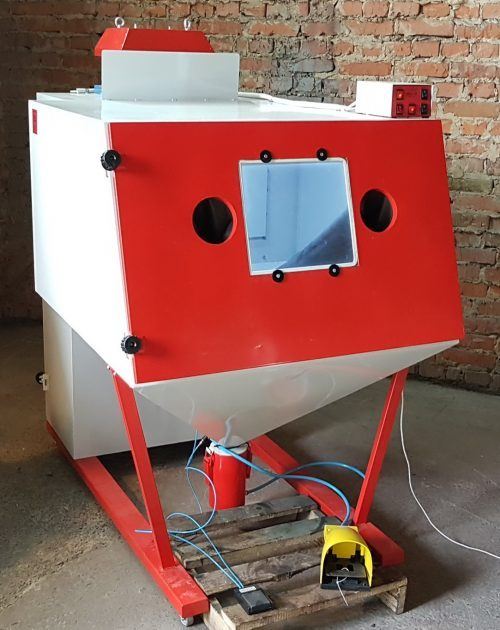
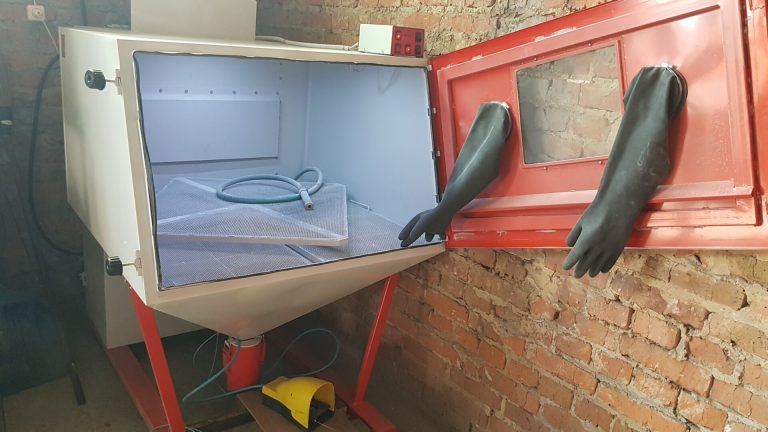
At this facility we accept for cleaning parts and products made of:
- steel and cast iron;
- copper and copper alloys (bronze, brass), copper-plated parts;
- aluminum, silumin and their alloys;
- titanium, its alloys;
- nickel-plated parts;
- galvanized materials;
- lead, tin
SANDBLASTING AND WATER BLASTING
 Sandblasting of metal is a mechanical cleaning technology obtained by the action of abrasive materials on a metal surface. The energy of the abrasive particles is supplied by a flow of compressed air, and then the air-abrasive mixture is supplied to the surface being treated.
Sandblasting of metal is a mechanical cleaning technology obtained by the action of abrasive materials on a metal surface. The energy of the abrasive particles is supplied by a flow of compressed air, and then the air-abrasive mixture is supplied to the surface being treated.
There are other names for this technology, for example, abrasive blasting, abrasive blasting, shot blasting, metal sandblasting, metal sandblasting, etc. – all this is nothing more than one method of surface preparation, in which the air-abrasive mixture is sprayed under pressure onto the surface, and the abrasive particles transfer kinetic energy to the surface and the substances on it.
This type of cleaning involves the action of abrasive materials on the surface of products. With the help of this technology, you can remove old coatings and all types of contamination, get rid of corrosion products.
Advantages of the technology
The main advantages of metal sandblasting include: high quality and speed of cleaning, cost-effectiveness and environmental friendliness of the presented method. Such cleaning is carried out using dust-free sandblasting machines and ejector sandblasting equipment. In our company, the price of sandblasting is very moderate and affordable.
 In our work we use both ejector sandblasting equipment and dust-free sandblasting machines.
In our work we use both ejector sandblasting equipment and dust-free sandblasting machines.
Dust-free sandblasting equipment has a number of advantages over conventional ejector and pressure open cleaning machines.
The essence of the technology is to supply an air-abrasive jet to the surface and simultaneously collect the used abrasive by a vacuum system, clean it from contamination and collect it for reuse.
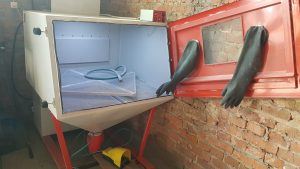 The closed cycle of abrasive movement in such devices allows the use of abrasive materials with high turnover, which results in a reduction in cleaning costs.
The closed cycle of abrasive movement in such devices allows the use of abrasive materials with high turnover, which results in a reduction in cleaning costs.
The need to collect spent abrasive at the cleaning site almost completely disappears, and the absence of dust in the work areamakes it possible to use dust-free sandblasting units in places where people are present without special protective equipment, for example, in populated areas, in residential and industrial premises.
Sandblasting
Sandblasting of metal was first used in the USA at the end of the 19th century, and since then sandblasting has been technically improved, leaving only the principle of the method unchanged – abrasive action with sand.
Sandblasting is a mechanical process of collision of a stream of sand, which has high kinetic energy, with a metal surface in order to free it from contaminants.
Sandblasting can be used not only for metal processing, but also for mechanical action on the surface of wood, concrete, glass and other materials.
Sandblasting of metal Dnepr from our company is used to work with products and structures made of rolled metal by mechanical means. The scope of use of the mechanical method sandblasting Kyiv is increasing. Consequently, the cost of the metal processing service is decreasing. The quality of sandblasting work Kharkov is constantly improving, new working materials appear, equipment for the option of mechanical processing of metals Sumy is updated.
What is sandblasting used for?
Sandblasting of metal Kharkov is the most popular method of abrasive cleaning of metal products.
Mechanical processing of metals Dnepr is used to clean metal surfaces from various types of contaminants – paint, scale, mold, dirt and stains, burnt-on deposits, soot, rust, as well as molding residues. Sandblasting helps to degrease the surface by mechanical action before electroplating or other mechanical work.
Before you start painting a metal product, or apply any other coating to it, it must be thoroughly cleaned, and it is best to do this by sandblasting metal Kyiv. Cleaning treatment of metal is mandatory and is provided for by GOST on paint and varnish coatings.
Sandblasting – degrees
Sandblasting of metal Sumy can be of different degrees, it all depends on what the goals are. The degree of sandblasting directly affects the cost of the service. The more thorough the sandblasting, the higher the price of metal processing. There are four degrees of metal processing, and they are as follows:
1. Mechanical deep sandblasting Sumy. With its help, such a noticeable result of metal processing is achieved that even with a 6-fold increase it will be impossible to record the presence of rust or scale on the surface of the product.
2. Medium-intensity mechanical sandblasting gives a visual cleanliness of the steel surface.
3. Surface mechanical sandblasting gives a moderate result of metal processing. Mechanical processing of metals Kyiv with this mechanical method leaves scale occupying no more than 5% of the steel surface.
4. Light mechanical processing of metals Kharkov. This mechanical type of metal processing removes old rust and exfoliating scale from the surface of the product.
Sandblasting – the nuances of the method
Sandblasting can give the metal surface varying degrees of roughness, from perfect shine to a noticeably rough surface. This depends on the fraction of the sand used and the force of its feed.
Sometimes during sandblasting of metal, mechanical destruction of its surface structure occurs, but this is not bad, but on the contrary, favorable. Such an event shows that on some area of the metal surface the rust has become very deep, and this area requires repair.
Sandblasting with mechanical crushing of the abrasive forms silicate dust, therefore, metal processing by this mechanical method requires the operator to have a special protective suit and a respirator, and in the room where sandblasting is carried out – a high-quality exhaust and good ventilation.
All materials for painting metal surfaces require mandatory mechanical preliminary treatment of the metal in order to roughen it, degrease it, and mechanically remove dirt. If you do not sandblast, the cost of painting Dnepr will not pay off. Sandblast is the most effective mechanical method of processing metal to prepare it for painting. If we compare sandblast with the results of a grinder, we will see that the speed of metal processing by mechanical sandblasting is tens of times higher at approximately the same cost of services. Obviously, sandblast is the most optimal choice for effective work with metal.
OUR TECHNICAL CAPABILITIES FOR SANDBLASTING AND WATERJET CLEANING
Dust-free sandblasting equipment
Working dimensions of the chamber: 1000×1000×500mm
Portable ejector sandblasting unit allows you to solve a wider range of tasks.
We also perform hydroabrasive processing using high-pressure devices.

OUR TECHNICAL CAPABILITIES FOR SANDBLASTING AND WATERJET CLEANING
Dust-free sandblasting equipment
Working dimensions of the chamber: 1000×1000×500mm
Portable ejector sandblasting unit allows you to solve a wider range of tasks.
We also perform hydroabrasive processing using high-pressure devices.

VIBRO-RUBBING
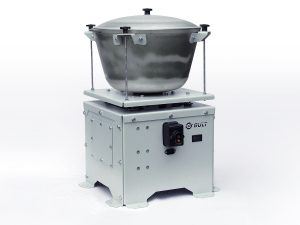 Tumbling is a modern, highly productive technology for processing the surface of various alloys and metal products, including jewelry, in an environment of abrasive bodies. It is widely used for finishing small-sized products, removing flash, scale, burrs, rust, blunting edges, smoothing sharp edges, and also for improving the quality of products by polishing the surface to a mirror shine. The method has become widespread in Ukraine due to its cost-effectiveness, practicality and simplicity.
Tumbling is a modern, highly productive technology for processing the surface of various alloys and metal products, including jewelry, in an environment of abrasive bodies. It is widely used for finishing small-sized products, removing flash, scale, burrs, rust, blunting edges, smoothing sharp edges, and also for improving the quality of products by polishing the surface to a mirror shine. The method has become widespread in Ukraine due to its cost-effectiveness, practicality and simplicity.
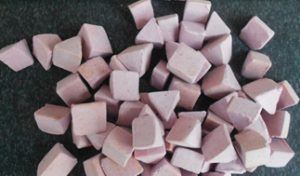 Tumbling in modern production has long become an integral part of the process of finishing operations and preparation of products for galvanic and powder coating processes. For high-quality surface treatment, we use various ceramic abrasive bodies, polishing pastes and compounds.
Tumbling in modern production has long become an integral part of the process of finishing operations and preparation of products for galvanic and powder coating processes. For high-quality surface treatment, we use various ceramic abrasive bodies, polishing pastes and compounds.
OUR TECHNICAL CAPABILITIES FOR VIBRO-RUBBING
We carry out cleaning and polishing of products using a 30-liter vibratory finishing unit.
Sandblasting and glass blasting
– are effective methods of cleaning and preparing metal before thermal or chemical treatment. Both methods use the force of a jet of abrasive material (sand or glass) to remove dirt, rust, paint and other coatings from the surface of the metal.
Sandblasting is used to remove thick layers of rust, coatings and stains from the surface of the metal. This method is often used to prepare the surface of the metal before painting, welding or other processing. It can also be used to create a pattern or texture on the surface of the metal.
Glass blasting, on the other hand, is used to remove thin layers of dirt and oxides from the surface of the metal. This method uses glass sand, which is finer than the sand used in sandblasting. It can be used to clean sensitive metal surfaces such as brass, aluminum and stainless steel.
In both methods, the abrasive jet creates a short-term contact that does not damage the base metal material, but is strong enough to remove all contaminants. After cleaning, the metal surface remains clean and ready for further processing.
Sandblasting and glass blasting are effective metal cleaning methods that help improve the quality of processing and extend the service life of the metal. If you need professional metal cleaning, contact us – we provide high-quality sandblasting and glass blasting services for metal.

